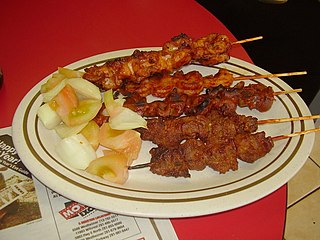 W
WNigerian cuisine consists of dishes or food items from the hundreds of ethnic groups that comprise Nigeria. Like other West African cuisines, it uses spices and herbs with palm or groundnut oil to create deeply flavored sauces and soups.
 W
WÀkàrà (Hausa: kosai, Portuguese: Acarajé is a type of fritter made from cowpeas; or beans - black eye peas. It is found throughout West African, Caribbean, and Brazilian cuisines. The dish is traditionally encountered in Brazil's northeastern state of Bahia, especially in the city of Salvador. Acarajé serves as both a religious offering to the gods in the Candomblé religion and as street food. The dish was brought by enslaved peoples from West Africa, and can still be found in various forms in Nigeria, Ghana, Togo, Benin, Mali, Gambia and Sierra Leone.
 W
WAfang soup, is a vegetable soup that originates from the Efik people of the Efik kingdom in Cross River State and the Ibibio People of Akwa Ibom in Southern Nigeria. It is a dish popularly known by Nigerians and also some parts of Africa. It is especially popular among the Ibibio and the Anang people of Akwa Ibom and Cross River state who have adopted this cuisine as part of their cultural identity. It is served at homes and also sometimes at ceremonies such as weddings, burials, festivals etc. mostly in the southern part of Nigeria. Afang soup is very nutritious and cost of preparation can be adaptable based on family needs. The ingredients used to prepare Afang soup include beef, fish, palm oil, crayfish, pepper, Shaki, waterleaf, okazi leaf, onion, periwinkle salt and some other seasonings.
 W
WAfri Food Network popularly known as African Food Network is a website that is dedicated to African food and lifestyle. The site was launched in January 2017 by Kevin Eze in Abuja, Nigeria.
 W
WÀmàlà is a local indigenous Nigerian swallow food, native to the Yoruba ethnic group in the western states of the country. It is made out of yam and/or cassava flour, or unripe plantain flour. Yams are peeled, sliced, cleaned, dried and then blended into a flour, also called èlùbọ́. Yams are white in colour but turn brown when dried. This gives àmàlà its colour. Àmàlà is from Western Africa and eaten mostly by the Yoruba people in Nigeria. Amala is mainly consumed by indigenous people of the Southwestern part of Nigeria. It could be served with a variety of ọbẹ (soups), such as ẹ̀fọ́, ilá, ewédú, ogbono or gbẹ̀gìrì.
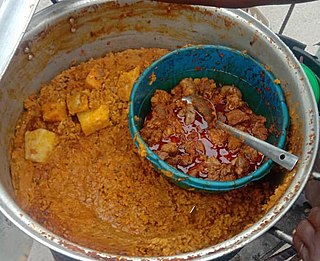 W
WBanga Rice is a traditional Nigerian food prepared with palm fruit like in palm nut soup. The dish is common among the Urhobo people of southern Nigeria. Banga is the juice extracted from palm nut fruit. It is called Banga rice after the juice extracted from the palm nut is cooked with parboiled white rice.
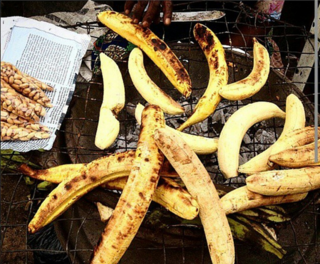 W
WBoli is a roasted plantain dish in Nigeria. It is native to the Yoruba people of Nigeria. It is referred to as 'boli' in South West Nigeria these people are known as the Yoruba people and is eaten with groundnuts. The Yorubas have been enjoying this delicacy for ages, it can be consumed as a snack or main meal which can be accompanied with pepper sauce filled with meat, roasted fish or fried chicken especially during the festive period. The word 'boli' is being pronounced as 'bole' due to a difference in accent in the south-south region in Nigeria. In South South Nigeria, it is referred to as 'bole' a borrowed language from the southwestern people in Nigeria and is eaten with fish during an important festival.
 W
WCooking bananas are banana cultivars in the genus Musa whose fruits are generally used in cooking. They may be eaten ripe or unripe and are generally starchy. Many cooking bananas are referred to as plantains or green bananas. In botanical usage, the term "plantain" is used only for true plantains, while other starchy cultivars used for cooking are called "cooking bananas". True plantains are cultivars belonging to the AAB Group, while cooking bananas are any cultivars belonging to AAB, AAA, ABB, or BBB groups. The currently accepted scientific name for all such cultivars in these groups is Musa × paradisiaca. Fe'i bananas from the Pacific Islands are often eaten roasted or boiled, and are thus informally referred to as "mountain plantains," but they do not belong to any of the species from which all modern banana cultivars are descended.
 W
WDodo Ikire is a traditional delicacy from Ikire in Osun State, Nigeria. It was originally made from leftover plantain but today, people prepare it from fresh ingredients which are: over-ripe plantains, pepper, oil and salt. Dodo Ikire is black and round or conical in shape.
 W
WDraw soup is a term given to certain soups originating from the southeastern and southwestern parts of Nigeria. They are made from okra, ogbono or ewedu leaves (jute). The term derives from the thick viscosity characteristic of the broth as it draws out of the bowl when eaten either with a spoon or, more characteristically, by dipping a small piece of solid (fufu) into it. It can be served with numerous Nigerian fufu meals, including eba (garri). Ewedu can be used to make a Yoruba soup that is traditionally served with amala.
 W
WẸ̀bà is a staple food mainly eaten in the West African sub-region, particularly in Nigeria and parts of Ghana. It is specifically called Eba by the Yoruba people. It is a swallow food made from dried grated cassava (manioc) flour, commonly known as garri.
 W
WẸchịcha is a dish native to the Igbo part of Nigeria consisting mainly of dried Cocoyam, mgbụmgbụ, and palm oil. It is traditionally eaten in the dry season when fresh vegetables are hard to come by.
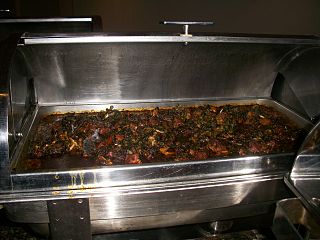 W
WEdikang ikong is a vegetable soup that originated among the Efik people of Cross River State and Akwa Ibom State in Southeastern Nigeria. It is considered to be a delicacy among some Nigerians, and is sometimes served during occasions of importance. Edikang ikong is a nutritious soup and expensive to prepare, and has been described as being mostly eaten by rich people in Nigeria. Ingredients used in edikang ikong include beef and dried fish, bush meat, crayfish, shaki, kanda, pumpkin leaves, water leaves, ugu, onion, periwinkle, palm oil, salt and pepper.
 W
WEfo riro is a vegetable soup and a native soup of the Yoruba people of western Nigeria. The two vegetables most commonly used to prepare the soup are Celosia argentea and Amaranthus hybridus.
 W
WEgusi is the name for the protein-rich seeds of certain cucurbitaceous plants, which after being dried and ground are used as a major ingredient in West African cuisine.
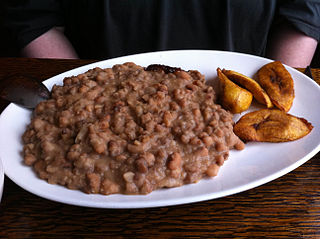 W
WEwa Aganyin is a street food commonly eaten across Nigeria. The beans are made to be extremely soft or mashed. It is commonly eaten with barely ground pepper and tomato sauce which is very spicy, but peppery. It has a local name of 'Ewa G'. Additional ingredients can include palm oil, onion and crayfish.
 W
WFufu is a dough-like food made from fresh or fermented cassava, found in West African as well as Caribbean cuisines. In addition to Ghana, it is also found in Sierra Leone, Guinea, Liberia, Cote D'Ivoire, Benin, Togo, Nigeria, Cameroon, the Democratic Republic of Congo, the Central African Republic, the Republic of Congo, Angola and Gabon. It is often made in the traditional Ghanaian, Cote D'ivoire, Liberia and Cuban method of separately mixing and pounding equal portions of boiled cassava with green plantain or cocoyam, or by mixing cassava/plantains or cocoyam flour with water and stirring it on a stove. The viscosity is then adjusted based on personal preference and eaten with broth-like soups. Some countries, particularly Nigeria, have a version of fufu made from fermented Cassava dough that is eaten with thick textured stews. Other flours, such as semolina, maize flour, or mashed plantains may take the place of cassava flour. Fufu is eaten with the fingers, and a small ball of it can be dipped into an accompanying soup or sauce
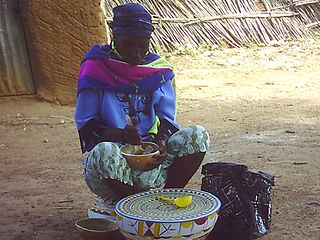 W
WFura is a type of food which is known to have originated from the Fulanis and Hausas in West Africa.It is a millet dough balls which is also eaten in Niger and Ghana.
 W
WIn West Africa, garri refers to the creamy granular flour obtained by processing the starchy tuberous roots of freshly harvested cassava.
 W
WIrú or Eware (Edo) is a type of fermented and processed locust beans used as a condiment in cooking. It is similar to ogiri and douchi. It is very popular among the Yoruba people and Edo people of Nigeria. It is used in cooking traditional soups like egusi soup, okro soup, Ewedu soup and ogbono soup. Among the Manding-speaking people of West Africa irú is known as sumbala. The Yorubas classify iru into two types: Irú Wooro which is commonly use in making stew and Irú pẹ̀tẹ̀ which is used in making ewedu and egusi soup.
 W
WIrvingia gabonensis is a species of African trees in the genus Irvingia, sometimes known by the common names wild mango, African mango, or bush mango. They bear edible mango-like fruits, and are especially valued for their fat- and protein-rich nuts.
 W
WJollof, or jollof rice, is a rice dish from West Africa. The dish is typically made with long-grain rice, tomatoes, onions, spices, vegetables and meat in a single pot, although its ingredients and preparation methods vary across different regions.
 W
WKilishi is a version of jerky that originated in Hausaland specifically Bauchi state. It is a dried form of suya, made from deboned cow, sheep or goat meat. Each of the selected muscles is sliced into sheets of one metre or less for easy drying. The dried sheets of meat are then collected and kept for the next process.
 W
WKoose is a spicy black-eyed pea fritter that is commonly eaten in West Africa as a snack.
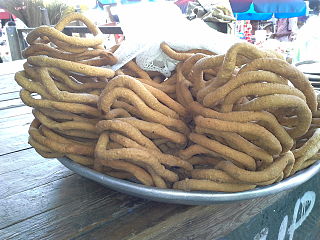 W
WKuli-kuli refers to a West African snack that is primarily made from peanuts. First made by the Nupe People of West Africa it is a popular snack in Nigeria, Benin, northern Cameroon and Ghana. It is often eaten alone or with a mixture of garri also known as cassava flakes, sugar and water popularly called "garri soakings". It is also eaten with Hausa koko, fura, kamu; and is sometimes ground and put into salad. It is often ground as used as an ingredient for Suya and Kilishi.
 W
WMoin-Moin or Moimoi is a Nigerian steamed bean pudding made from a mixture of washed and peeled black-eyed beans, onions and fresh ground red peppers. It is a protein-rich food that is a staple in Nigeria.
 W
WNsala soup is made with small pieces of yam with utazi leaves. The soup originates from the Eastern part of Nigeria A major ingredient of Nsala Soup is the cat fish which gives the soup a unique taste. Nsala is similar to Afia Efere common among the Efik ethnic group.
 W
WObalende Suya Express, Obalende Suya or Suya Express is a Nigerian restaurant in London, England. The restaurant has two branches, one, a takeaway located 43 Peckham High Street, Peckham, not far west from Peckham Library and a restaurant located at 523 Kingsland Road in Dalston, Hackney. It is named after Obalende, a neighborhood on Lagos Island in Lagos, Nigeria and suya, a grilled kebab like dish, popular in Nigeria. The restaurant was founded in the summer of 1987 and opened its first branch in 1991, opening the Peckham High Street outlet in the summer of 1992.
 W
WOfada rice is a name for heritage varieties of rice grown in south-west Nigeria. It is used in a variety of dishes. Ofada rices are mostly blends, and some of the rice varieties in the blends are not indigenous to Africa; however, they usually also contain African rice. It is grown almost exclusively in Ogun State, a state in Southwestern Nigeria. It is named after the town Ofada in Ogun State.
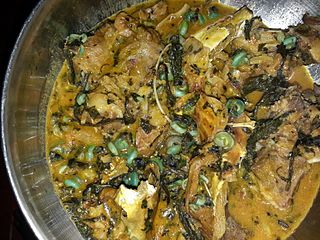 W
WOgbono soup, is a Nigerian dish made with ground dry ogbono seeds. Ogbono seeds are originated and were first grown in Southern Nigeria. with considerable local variation. According to research by Chris Chinaka and J.C. Obiefuna, Ogbono is an indigenous forest tree associated with plants classified as 'non-timber forest products. It goes by various indigenous names in Nigeria. In the Igbo speaking region it is called 'ogbono/ugiri' depending on the variety of Igbo. In Nupe, it is called 'pekpeara', 'ogwi' in Bini, 'uyo' in Efik and 'oro' in Yoruba.
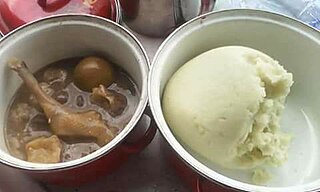 W
WOkoho is the main traditional food peculiar to the Idoma people of Benue State, Central Nigeria. It is made from the plant Cissus populnea belonging to the family Amplidaceae (Vitaceae).
 W
WPalaver sauce or palava sauce or plasas is a type of stew widely eaten in West Africa, including Ghana, Liberia, Sierra Leone and Nigeria. The word palaver comes from the Portuguese language and means a talk, lengthy debate or quarrel. It is unclear how this led to the name of the stew. One theory is that the spices used in the stew mingle together like raised voices in an argument. It has been thought of as having the power to calm tensions, or to cause them. Other names for the dish include Kontonmire, Kentumere, Nkontommire and pla'sas.
 W
WPalm wine, known by several local names, is an alcoholic beverage created from the sap of various species of palm tree such as the palmyra, date palms, and coconut palms. It is known by various names in different regions and is common in various parts of Africa, the Caribbean, South America, South Asia, Southeast Asia and Micronesia.
 W
WPeanut stew or groundnut stew, also called as maafe, sauce d'arachide (French), tigadèguèna or domoda, is a stew that is a staple food in Western Africa. It originates from the Mandinka and Bambara people of Mali.
 W
WPeppersoup is a soup from parts of West Africa, notably Nigeria that is prepared using various meats, chili peppers and calabash nutmeg as primary ingredients. It is a spicy soup that has a light, watery texture. It is considered to be a delicacy by some people in Western Africa, and some West Africans believe that the soup has medicinal qualities.
 W
WPottage or potage is a term for a thick soup or stew made by boiling vegetables, grains, and, if available, meat or fish. It was a staple food for many centuries. The word pottage comes from the same Old French root as potage, which is a dish of more recent origin.
 W
WPuff-puff, as it is called in Nigeria and Sierra Leone, sometimes Ghana, and in anglophone Cameroon, is a traditional African snack made of fried dough. Other names for the food include buffloaf in Ghana, bofloto in the Ivory Coast, mikate in Congo, micate or bolinho in Angola, beignet in Francophone Cameroon, ligemat in Sudan, kala in Liberia, Vetkoek / Amagwinya/Magwinya in South Africa and Zimbabwe. The prominence of this delicacy stretches even to the eastern and southern edges of West Africa, where it is mostly known as mandazi.
 W
WSuya or tsire is a spicy meat skewer which is a popular food item in West Africa. It is also eaten in Sudan, referred to as "Agashe". Suya is generally made with skewered beef, ram, or chicken. Innards such as kidney, liver and tripe are also used. The thinly sliced meat is marinated in various spices which include peanut cake, salt, vegetable oil and other flavorings, and then barbecued. Suya is served with extra helpings of dried pepper mixed with spices and sliced onions. Halal meat preparation methods are normally used, especially in the northern parts of Nigeria, where the suspicion of nonconformity to Muslim dietary prohibitions in Suya preparation has been known to cause riots. A dried version of Suya is called Kilishi. It can be eaten with Garri or Ogi.
 W
WTuwon shinkafa is a type of Nigerian and Niger dish from Niger and the northern part of Nigeria. It is a thick pudding prepared from a local rice or Maize or millet that is soft and sticky, and is usually served with different types of soups like Miyan kuka, Miyan kubewa, Miyan taushe.
 W
WWest African cuisine encompasses a diverse range of foods that are split between its 16 countries. In West Africa, many families grow and raise their own food, and within each there is a division of labor. Indigenous foods consist of a number of plant species and animals, and are important to those whose lifestyle depends on farming and hunting.